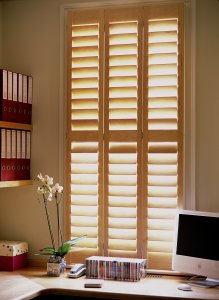window shutters

Window shutters – both interior and exterior – can help reduce heat gain and loss in your home.
Interior shutters need a clear space to the side of the window when they're opened. They also require hardware that is fastened to the window jams or trim. Properly designed exterior shutters may provide the best possible window insulation system. They offer several advantages:
• Weather protection
• Added security
• No use of interior space
• No thermal shock to windows if left closed
Exterior shutters must be integrated into your home's architecture. Their mounting, drainage, and hinging will require special consideration; it's easier to address these design issues in new construction.
Most exterior shutter systems include a mechanical crank, rod, or motor to allow operation from indoors. This can help encourage daily use of the shutters, and may be required by local fire codes.
Roll-down metal exterior shutters are often used as protection against storms and/or vandalism. While metal shutters provide protection against these hazards, they don't provide much of a barrier against air infiltration and heat.
Like window blinds, louvered shutters work best for summer shading. Movable or fixed louvers allow ventilation and natural daylight to enter a room while blocking some direct radiation. However, they won't provide much insulation against heat loss in the winter.
Solid shutters will decrease both heat loss and summer heat gain. These insulating shutters consist of wood panels, a vapor barrier, and sometimes a decorative covering. If you fit them tightly against a window frame, they'll provide an insulating air space between the shutter and the window.
You can combine shutters with other window treatments, such as draperies, for greater insulating ability.
